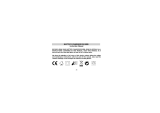
GMC-I Messtechnik GmbH 17
12 Using the Menus – from the Initial InFO Menu to
Operating and Measuring Parameters
Menu-driven operation via the initial „1NF0 “ menu allows the
user to query online help, activate the memory and query
memory occupancy, activate the interface and configure
device parameters.
Ð The initial „1NF0 “ menu is accessed by simultaneously
pressing and holding the FUNC and ON|OFF keys with the
instrument switched on, until „1NF0 “ appears at the
display.
Ð The display can be switched from the main „1NF0 “ menu
to the other main menus including “store“, “memo”, “ send”
and “set”, and then back to the „1NF0 “ menu, by
repeatedly pressing the keys.
Ð After accessing the desired main menu, the associated
submenus are opened by activating the key.
Ð The desired parameter or the desired function is selected
by repeatedly pressing the keys.
Ð Acknowledge with the key in order to change the
corresponding parameter or parameters.
Ð After the desired digit has been selected with the
keys and the value has been adjusted with the keys,
the next digit is accessed with the key, or the display is
returned to the start menu or switched to the next
submenu.
Ð The measuring mode is started by repeatedly pressing
the FUNC key until the measuring display appears.
Ð The multimeter is switched off by pressing and holding
the ON|OFF key until the display goes blank.
The following pages include an overview of the menu
structure.
12.1 Sampling rAtE
The sampling rate specifies the time interval after which the
respective measured value is transmitted to the interface or to
measured value memory.
Certain sampling rate limit values apply to various measured
quantities, and these may not be exceeded (see table below).
12.2 Saving Measured Values
The METRA HIT
27 provides two entirely different options for
storing data:
• Measured Value Memory – DATA Key Function:
Each time a measuring point is contacted, a measured
value is stored in accordance with a defined condition
(see chapter 5.1 and chapter 12.2.1).
• Memory Mode Operation – STORE Menu Function:
After activating the STORE menu function, all measured
values are saved in accordance with the selected
sampling rate. Memory mode operation is ended
manually using the same menu function.
In both cases, saved measured values can be read out with
the help of METRAwin10 PC software (as of version 5.22).
However, read-out is only possible if a USB-HIT IR adapter
has been plugged into the METRA HIT27 and connected to
the PC with an interface cable.
12.2.1 Memory Mode – DATA Key Function (see also chapter 5.1)
The instrument is equipped with a measured value memory
(32 kB) which is synchronized with a quartz movement, and
has an average capacity of 1000 measured values. Minimum
capacity is 800 measured values and maximum capacity is
1200 measured values.
Data are stored and can be transmitted directly to a PC with
the METRAwin10 software. Date and time must be reset if
the storage batteries are depleted or the batteries or storage
batteries are replaced.
Measured values are stored in so-called blocks. Measured
values resulting from the same measuring function are saved
to the same block.
Only absolute values and absolute time stamps can be
saved, i.e. no relative or values, and no relative time
stamps.
Memory content can only be read out with the help of a PC,
an IR adapter (USB-HIT), and METRAwin10 analysis
software.
Stored measurement data blocks are retained even if the
instrument is without voltage supply.
Preparing for Memory Mode Operation
Ð First set the sampling rate for memory mode operation,
and then start memory mode operation.
The sampling rate can also be changed during memory
mode operation.
Ð First select the desired measuring function and an
appropriate measuring range.
Ð Check the storage battery charge level before starting
long-term measurement recordings (see chapter 14.1 on
page 25). Connect the mains power battery charger if
applicable.
Measured Quantity Sampling Rate
V0.5s
V , 0.5 s
m
, C (Pt100, Pt1000) 0.5 s
Hz 1 s
m@1A 1.5 s





















